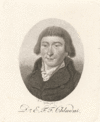Meteorite Fall Augsburg (1528)
| Meteorite Fall Augsburg (1528) | |
|---|---|
| place | augsburg |
| Fall time | June 29, 1528 |
| authenticity | controversial |
After a meteorite is said to have fallen in Augsburg as early as 952 , chroniclers report again about a meteorite fall in 1528 , at a time when the religious delusion was rampant in Augsburg that the end of the world was imminent, which is why there are doubts about its authenticity . In addition, the sources are poor. A strong thunderstorm combined with hail cannot be ruled out for the supposed human observations .
background
In Augsburg at that time the delusion was rampant that the world would end at Pentecost 1528 . Responsible for this was v. a. Hans Hut . Hut became a member of a radical Christian movement two years before the alleged apocalypse . He became a Baptist and believed in the apocalyptic dawn of the Kingdom of God at Pentecost 1528. He displayed missionary zeal to convert and baptize 144,000 skeptics. Hut's visions of the end of the world cannot have been triggered by the fall of the meteorite, because the world was supposed to end at the end of May 1528, but the fall of the meteorite is said to have happened about four weeks later.
However, the theory that the apocalyptic prophecies were due to the fall of a heavenly messenger is not completely refuted. Because after Hans Hut was arrested in August 1527, Augustin Bader took over his mission. From the spring of 1528 onwards, he held large open-air meetings outside the city in order to prepare the Anabaptist sect for the Last Judgment on Pentecost. When Pentecost passed uneventfully, the Augsburg Anabaptist congregation lost its enthusiasm. But shortly after the meteorite fall in question on June 29, Bader had three apocalyptic visions of the impending end of the world for Easter 1530. This time the coincidence would fit. Such heavenly signs would have come in handy for a fanatical doom preacher to substantiate the credibility of his prophecies.
Reports
Achilles Pirminius Gasser
The historian, physician and astrologer Achilles Pirminius Gasser (also Gasserus; born on November 3, 1505 in Lindau (Lake Constance) , died on December 4, 1577 in Augsburg ) was co-author of a chronicle of Augsburg in the 16th century. He wrote:
" This was followed on June 29 by a terrible hail with impetuous winds, which not only did two miles away on fruits and trees, but only in this place alone caused several thousand gold coins and, as they say, broke over 6000 fl. Glass panes. "
Ernst Florens Friedrich Chladni
In the 19th century, the meteorite researcher Ernst Florens Friedrich Chladni unearthed the vague statement from old chronicles “that on June 29, 1528, that is, on the commemoration day of St. Peter and Paul near Augsburg, large stones fell with a strong thunderstorm, as if they were knocked out Rifles would have shot ”. Chladni also stated in 1819 that chroniclers at that time should have actually meant a fire meteor with a thunderstorm accompanied by a thunderous crash. And the description that stones fell as if they had been shot out of a box made him suspect that it might not have been hail, but a meteor stone fall. These meteorites usually come down “in a very crooked direction”. Chladni referred with his conjectures to the Saxon Chronicon by Mathäus Dresser (1536-1607).
Inconsistencies
Gasser was just 22 years old at the time of the meteor shower or hail shower in question. And the Dresser quoted by Chladni was not born until 1536. Both of these factors together raise doubts that a meteorite actually fell over Augsburg in 1528.
literature
- Bavarian State Office for the Environment : Out of this world. Bavaria's meteorite. Self-published, Augsburg 2012, ISBN 978-3-936385-92-2 .



